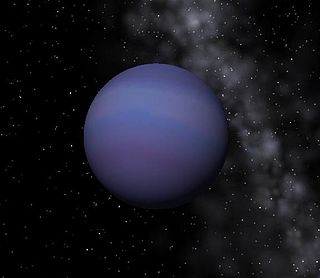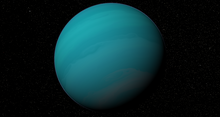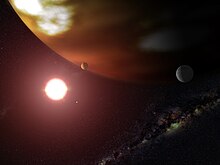Mu Arae, often designated HD 160691, officially named Cervantessur-VAN-teez, is a main sequence G-type star approximately 50 light-years away from the Sun in the constellation of Ara. The star has a planetary system with four known extrasolar planets, three of them with masses comparable with that of Jupiter. Mu Arae c, the innermost, was the first hot Neptune or super-Earth discovered.

Gliese 876 is a red dwarf star 15.2 light-years away from Earth in the constellation of Aquarius. It is one of the closest known stars to the Sun confirmed to possess a planetary system with more than two planets, after GJ 1061, YZ Ceti, Tau Ceti, and Wolf 1061; as of 2018, four extrasolar planets have been found to orbit the star. The planetary system is also notable for the orbital properties of its planets. It is the only known system of orbital companions to exhibit a near-triple conjunction in the rare phenomenon of Laplace resonance. It is also the first extrasolar system around a normal star with measured coplanarity. While planets b and c are located in the system's habitable zone, they are giant planets believed to be analogous to Jupiter.

Gliese 436 is a red dwarf located 31.9 light-years away in the zodiac constellation of Leo. It has an apparent visual magnitude of 10.67, which is much too faint to be seen with the naked eye. However, it can be viewed with even a modest telescope of 2.4 in (6 cm) aperture. In 2004, the existence of an extrasolar planet, Gliese 436 b, was verified as orbiting the star. This planet was later discovered to transit its host star.

54 Piscium is an orange dwarf star approximately 36 light-years away in the constellation of Pisces. In 2003, an extrasolar planet was confirmed to be orbiting the star, and in 2006, a brown dwarf was also discovered orbiting it.
HD 28185 is a yellow dwarf star similar to the Sun located 128 light-years away from Earth in the constellation Eridanus. The designation HD 28185 refers to its entry in the Henry Draper catalogue. The star is known to possess one long-period extrasolar planet.
Gliese 581 is a red dwarf star of spectral type M3V at the center of the Gliese 581 planetary system, about 20.5 light years away from Earth in the Libra constellation. Its estimated mass is about a third of that of the Sun, and it is the 101st closest known star system to the Sun. Gliese 581 is one of the oldest, least active M dwarfs known. Its low stellar activity improves the likelihood of its planets retaining significant atmospheres, and lessens the sterilizing impact of stellar flares.

HD 28185 b is an extrasolar planet 128 light-years away from Earth in the constellation of Eridanus. The planet was discovered orbiting the Sun-like star HD 28185 in April 2001 as a part of the CORALIE survey for southern extrasolar planets, and its existence was independently confirmed by the Magellan Planet Search Survey in 2008. HD 28185 b orbits its sun in a circular orbit that is at the inner edge of its star's habitable zone.

Gliese 581b or Gl 581b is an exoplanet orbiting within the Gliese 581 system. It is the first planet discovered of three confirmed in the system so far, and the second in order from the star.

Gliese 876 d is an exoplanet 15.2 light-years away in the constellation of Aquarius. The planet was the third planet discovered orbiting the red dwarf Gliese 876, and is the innermost planet in the system. It was the lowest-mass known exoplanet apart from the pulsar planets orbiting PSR B1257+12 at the time of its discovery. Due to its low mass, it can be categorized as a super-Earth.

Gliese 876 c is an exoplanet orbiting the red dwarf Gliese 876, taking about 30 days to complete an orbit. The planet was discovered in April 2001 and is the second planet in order of increasing distance from its star.

16 Cygni Bb or HD 186427 b is an extrasolar planet approximately 69 light-years away in the constellation of Cygnus. The planet was discovered orbiting the Sun-like star 16 Cygni B, one of two solar-mass (M☉) components of the triple star system 16 Cygni in 1996. It orbits its star once every 799 days and was the first eccentric Jupiter and planet in a double star system to be discovered. The planet is abundant in lithium.
Upsilon Andromedae d, formally named Majriti, is a super-Jupiter exoplanet orbiting within the habitable zone of the Sun-like star Upsilon Andromedae A, approximately 44 light-years away from Earth in the constellation of Andromeda. Its discovery made it the first multiplanetary system to be discovered around a main-sequence star, and the first such system known in a multiple star system. The exoplanet was found by using the radial velocity method, where periodic Doppler shifts of spectral lines of the host star suggest an orbiting object.

A Super-Earth is a type of exoplanet with a mass higher than Earth's, but substantially below those of the Solar System's ice giants, Uranus and Neptune, which are 14.5 and 17 times Earth's, respectively. The term "super-Earth" refers only to the mass of the planet, and so does not imply anything about the surface conditions or habitability. The alternative term "gas dwarfs" may be more accurate for those at the higher end of the mass scale, although "mini-Neptunes" is a more common term.
Gliese 86 is a K-type main-sequence star approximately 35 light-years away in the constellation of Eridanus. It has been confirmed that a white dwarf orbits the primary star. In 1998 the European Southern Observatory announced that an extrasolar planet was orbiting the star.

GJ 3021 b, also known as Gliese 3021 b or HD 1237 b, is an extrasolar planet approximately 57 light-years away, orbiting its bright G-dwarf parent star in the Southern constellation of Hydrus. It was discovered with the Swiss Euler Telescope at the Chilean La Silla Observatory in 2000.
Gliese 849 b is an extrasolar planet approximately 29 light years away in the constellation of Aquarius. It is the first long-period Jupiter-like planet discovered around a red dwarf, announced in August 2006 by the California and Carnegie Planet Search team using the radial velocity technique. The previously longest-period Jupiter-like planet around a red dwarf was Gliese 876 b. There are, however, two disproven longer period Jupiter-like planets around Lalande 21185. There are indications of a possible second companion. The planet's mass is less than that of Jupiter, though only the minimum mass is known. The distance of the planet is 2.35 AU and it takes 5.17 years to revolve in a circular orbit.

Gliese 86 b, sometimes referred to as Gliese 86 A b and/or shortened to Gl 86 b, is an extrasolar planet approximately 35 light-years away in the constellation of Eridanus. The planet was discovered orbiting a K-type main-sequence star by French scientists in November 1998. The planet orbits very close to the star, completing an orbit in 15.78 days.

Gliese 876 e is an exoplanet orbiting the star Gliese 876 in the constellation of Aquarius. It is in a 1:2:4 Laplace resonance with the planets Gliese 876 c and Gliese 876 b: for each orbit of planet e, planet b completes two orbits and planet c completes four. This configuration is the second known example of a Laplace resonance after Jupiter's moons Io, Europa and Ganymede. Its orbit takes 124 days to complete.

An exoplanet is a planet located outside the Solar System. The first evidence of an exoplanet was noted as early as 1917, but was not recognized as such until 2016; no planet discovery has yet come from that evidence. What turned out to be the first detection of an exoplanet was published among a list of possible candidates in 1988, though not confirmed until 2003. The first confirmed detection came in 1992, with the discovery of terrestrial-mass planets orbiting the pulsar PSR B1257+12. The first confirmation of an exoplanet orbiting a main-sequence star was made in 1995, when a giant planet was found in a four-day orbit around the nearby star 51 Pegasi. Some exoplanets have been imaged directly by telescopes, but the vast majority have been detected through indirect methods, such as the transit method and the radial-velocity method. As of 1 December 2023, there are 5,550 confirmed exoplanets in 4,089 planetary systems, with 887 systems having more than one planet. This is a list of the most notable discoveries.
















